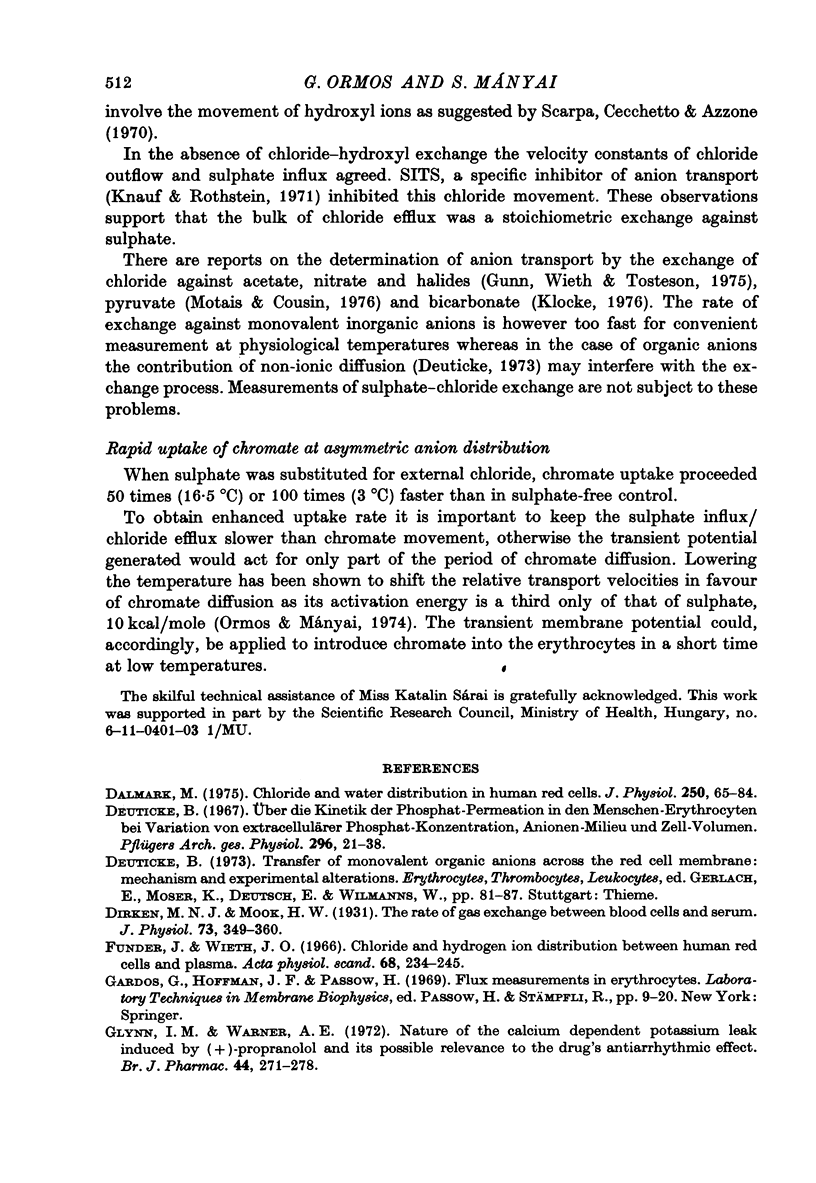Abstract
1. The exchange of sulphate for chloride across the human red cell membrane was measured in both directions, i.e. by sulphate influx and sulphate efflux. The influence of the concomitant transient pH changes was minimized by phosphate buffer and by choosing experimental conditions of moderate pH sensitivity (pH 6.4 and 7.8). Sulphate self exchange was determined in chloride-free erythrocyte suspensions. 2. The transport of external sulphate into red cells proceeded at a 15-fold greater rate if its initial concentration was raised from 5 to 95 mM. In contrast the velocity constant of sulphate efflux into sodium chloride medium increased only twofold when the intracellular sulphate concentration was increased. To explain this asymmetry it is proposed that external sulphate ions are more able to complete with chloride for the anion transport sites that those present in the cell interior. 3. The transient membrane potential due to the uneven distribution of sulphate and chloride was shown by the rapid introduction of chromate into the cells. When the erythrocytes contained chloride and the external anion was sulphate, the cells took up chromate 50 times (16.5 degrees C) faster than with equilibrium chloride distribution. 4. Chloride efflux into sodium sulphate media was measured by a chloride-sensitive electrode. Under buffered conditions in neutral and alkaline media two kinetic components were observed as the result of chloride exchange against hydroxyl and sulphate ions. At pH 6.4, chloride efflux was characterized by a single velocity constant identical to that of sulphate movement in the opposite direction. The results show that under appropriate circumstances net chloride efflux measurements can provide comparative data on the anion permeability of the red cell membrane.
Full text
PDF












Selected References
These references are in PubMed. This may not be the complete list of references from this article.
- Dalmark M. Chloride and water distribution in human red cells. J Physiol. 1975 Aug;250(1):65–84. doi: 10.1113/jphysiol.1975.sp011043. [DOI] [PMC free article] [PubMed] [Google Scholar]
- Dirken M. N., Mook H. W. The rate of gas exchange between blood cells and serum. J Physiol. 1931 Dec 17;73(4):349–360. doi: 10.1113/jphysiol.1931.sp002816. [DOI] [PMC free article] [PubMed] [Google Scholar]
- Glynn I. M., Warner A. E. Nature of the calcium dependent potassium leak induced by (+)-propranolol, and its possible relevance to the drug's antiarrhythmic effect. Br J Pharmacol. 1972 Feb;44(2):271–278. doi: 10.1111/j.1476-5381.1972.tb07263.x. [DOI] [PMC free article] [PubMed] [Google Scholar]
- Gunn R. B., Wieth J. O., Tosteson D. C. Some effects of low pH on chloride exchange in human red blood cells. J Gen Physiol. 1975 Jun;65(6):731–749. doi: 10.1085/jgp.65.6.731. [DOI] [PMC free article] [PubMed] [Google Scholar]
- Hoffman J. F., Laris P. C. Determination of membrane potentials in human and Amphiuma red blood cells by means of fluorescent probe. J Physiol. 1974 Jun;239(3):519–552. doi: 10.1113/jphysiol.1974.sp010581. [DOI] [PMC free article] [PubMed] [Google Scholar]
- Hunter F. R. Kinetic analysis of the permeability of human erythrocytes to NH4C1. J Gen Physiol. 1968 Apr;51(4):579–587. doi: 10.1085/jgp.51.4.579. [DOI] [PMC free article] [PubMed] [Google Scholar]
- Hunter M. J. A quantitative estimate of the non-exchange-restricted chloride permeability of the human red cell. J Physiol. 1971 Oct;218 (Suppl):49P–50P. [PubMed] [Google Scholar]
- Lassen U. V., Pape L., Vestergaard-Bogind B. Effect of calcium on the membrane potential of Amphiuma red cells. J Membr Biol. 1976 Feb 17;26(1):51–70. doi: 10.1007/BF01868866. [DOI] [PubMed] [Google Scholar]
- Lepke S., Passow H. Asymmetric inhibition by phlorizin of sulfate movements across the red blood cell membrane. Biochim Biophys Acta. 1973 Mar 16;298(2):529–533. doi: 10.1016/0005-2736(73)90379-9. [DOI] [PubMed] [Google Scholar]
- Ormos G., Mányai S. Chromate uptake by human red blood cells: comparison of permeability for different divalent anions. Acta Biochim Biophys Acad Sci Hung. 1974;9(3):197–207. [PubMed] [Google Scholar]
- Passow H. Passive ion permeability of the erythrocyte membrane. Prog Biophys Mol Biol. 1969;19(2):423–467. [PubMed] [Google Scholar]
- SCHWIETZER C. H., PASSOW H. Kinetik und Gleichgewichte bei der langsamen Anionenpermeabilität roter Blutkörperchen. Pflugers Arch. 1953;256(6):419–445. doi: 10.1007/BF00370058. [DOI] [PubMed] [Google Scholar]
- Sarkadi B., Szász I., Gárdos G. The use of ionophores of rapid loading of human red cells with radioactive cations for cation-pump studies. J Membr Biol. 1976 May;26(4):357–370. doi: 10.1007/BF01868883. [DOI] [PubMed] [Google Scholar]
- Scarpa A., Cecchetto A., Azzone G. F. The mechanism of anion translocation and pH equilibration in erythrocytes. Biochim Biophys Acta. 1970;219(1):179–188. doi: 10.1016/0005-2736(70)90073-8. [DOI] [PubMed] [Google Scholar]
- Schnell K. F., Gerhardt S., Schöppe-Fredenburg A. Kinetic characteristics of the sulfate self-exchange in human red blood cells and red blood cell ghosts. J Membr Biol. 1977 Jan 28;30(4):319–350. doi: 10.1007/BF01869675. [DOI] [PubMed] [Google Scholar]
- Schnell K. F. On the mechanism of inhibition of the sulfate transfer across the human erythrocyte membrane. Biochim Biophys Acta. 1972 Sep 1;282(1):265–276. doi: 10.1016/0005-2736(72)90333-1. [DOI] [PubMed] [Google Scholar]
- Till U., Koehler W., Loesche W. Rapid and complete separation of red cells from 32 P-orthophosphate containing medium. Acta Biol Med Ger. 1972;28(1):51–62. [PubMed] [Google Scholar]
- USSING H. H. Some aspects of the application of tracers in permeability studies. Adv Enzymol Relat Subj Biochem. 1952;13:21–65. doi: 10.1002/9780470122587.ch2. [DOI] [PubMed] [Google Scholar]
- Zaki L., Fasold H., Schuhmann B., Passow H. Chemical modification of membrane proteins in relation to inhibition of anion exchange in human red blood cells. J Cell Physiol. 1975 Dec;86(3 Pt 1):471–494. doi: 10.1002/jcp.1040860305. [DOI] [PubMed] [Google Scholar]


